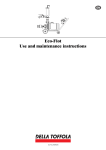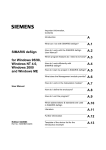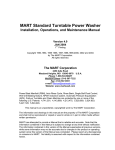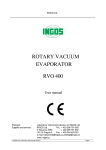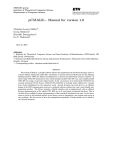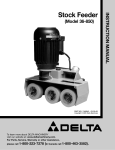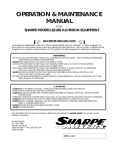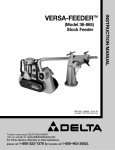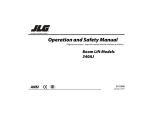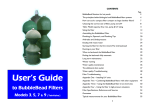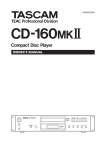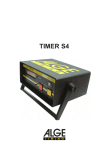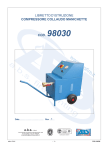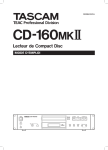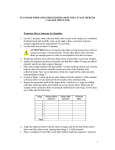Download Navod k pouziti nevybusnych asynchronnich motoru_eng
Transcript
EM Brno s.r.o. Jílkova 124 615 32 Brno INSTRUCTIONS FOR USE OF EXPLOSION-PROOF INDUCTION MOTORS OF AOM, AVM & AKM SERIES and H = 71-200 mm SHAFT HEIGHTS Flame-proof enclosure “d” User manual 9226244110 Table of contents: EM Brno s.r.o............................................................................................................................................................. 1 User manual 9226244110 .......................................................................................................................................... 1 Table of contents:....................................................................................................................................................... 2 1. Terminology ........................................................................................................................................... 3 2. Standards ................................................................................................................................................ 4 3. Power plate........................................................................................................................................... 5 4. Examples of safe use of electric motors according to explosion resistance............................................ 6 5. Type designation .................................................................................................................................... 7 6. Basic electromechanical parameters....................................................................................................... 7 7. Shapes ................................................................................................................................ ....................9 8. Basic design information ........................................................................................................................ 9 9. Connecting facilities ............................................................................................................................. 10 10. Cable entries........................................................................................................................................ .11 11. Storage.................................................................................................................................................. 12 12. Installation............................................................................................................................................ 12 13. Safety.................................................................................................................................................... 15 14. First putting into service ....................................................................................................................... 16 15. Operation tests & measuring ................................................................................................................ 16 16. Operation and service........................................................................................................................... 17 17. Maintenance ......................................................................................................................................... 17 18. Bearings................................................................................................................................................ 18 19. Disassembly.......................................................................................................................................... 20 20. Motor disassembly procedure............................................................................................................... 20 21. Check of joints and explosion-proof enclosure parts............................................................................ 21 22. Assembly .............................................................................................................................................. 21 23. Inspections, revisions ........................................................................................................................... 21 24. Failures ................................................................................................................................................. 21 25. Spare parts - ordering ........................................................................................................................... 23 26. Repairs.................................................................................................................................................. 23 27. Warranty............................................................................................................................................... 23 28. Table of spare parts of AOM, AVM & AKM series ............................................................................ 24 29. List of parts........................................................................................................................................... 25 30. List of attachments................................................................................................................................ 25 31. Contacts................................................................................................................................................ 26 Page 2 (of 26) Revision as of 07/11/15 These Instructions for Use contain basic information on the protective system of electric motors in terms of their explosion resistance, and also determine the main principles for their safe use, i.e. installation, putting into service, operation, inspection, maintenance and repairs. Troublefree and safe operation depends mainly on adhering to all principles specified in this manual and in related standards. Electric motors as such are not source of explosive atmosphere, which means that their operation does not create any explosive gas constituents. In addition, they are designed, along with obligatory safety elements through which they have to be powered, to prevent initiation of explosive atmosphere even in case of potential failure or any reasonably anticipated misuse. An important presupposition of this is, that assembly, inspections, maintenance and revisions are carried out by qualified workers skilled in work with explosion-proof electric devices, whilst professional supervision is performed by an authorized person. 1. Terminology Environment with explosion danger An environment with risk of explosive atmosphere generation, due to local and operating conditions. Explosive atmosphere Mixture of air with flammable substances in form of gases, vapours, mists or dusts at atmospheric conditions in which, after initiation, burning spreads into unburned mixture. Type of protection Special precautions (aids) used for electric device in order to eliminate initiation of ambient explosive atmosphere. Ambient temperature Temperature of air or another media in proximity of electric motor. Maximum surface temperature Highest temperature which is generated during operation in most unfavourable conditions (although within allowed tolerances) on any part of electric motor, which may cause ignition of ambient explosive atmosphere. Enclosure All walls, doors, covers, cable entries, shafts, pull rods, etc., which assist in protection against explosion or to the level of electric device protection (IP). Flame proof enclosure “d” Enclosure, parts of which, capable of igniting explosive atmosphere, are located inside the enclosure; this enclosure resists to explosion pressure if explosive mixture explodes inside the enclosure, and prevents transfer of the explosion into the ambient explosive atmosphere. Bushing Insulation device leading one or more conductors through internal or external part of enclosure. Cable entry Device enabling to convey one or more electrical or optical fibre cables into electric device to preserve corresponding type of protection. Clamping device Part of cable entry preventing from transfer of tension or cable twist to connections. Sealing ring Ring used in cable entry or in conducting tube for sealing between the cable entry and the cable or conducting tube. Ex cable entry Cable entry tested separately from electric motor enclosure which was certified as device, and which can be connected to electric motor enclosure during installation. Page 3 (of 26) Revision as of 07/11/15 Certificate Document which confirms compliance of product, process, person or organization with prescribed requirements. Connecting facility Clamps, screws and other components used for electric device in order to preserve the corresponding type of protection against explosion. Terminal compartment Separate part of flame proof enclosure containing a connecting device, and connected with electric motor flame proof enclosure through bushing or bushings. Ex part Part of electric device or module (other than the Ex cable entry) marked with “U” symbol, which is not designed to be used separately, and which requires additional verification when built in electric device or system designed for use in an environment with explosion danger. Drive end side (D side) – is a side from which mechanical power is lead off. Non drive end side Side opposite to drive end side (N side). 2. Standards According to this Manual, the below listed technical standards apply to explosion-proof induction motors: 2.1 Standards applicable for explosion resistance CSN EN 1127-1: Explosive environments – Prevention and protection against explosion – Part 1: Basic terms and methodology. CSN EN 1127-2: Explosive environments – Prevention and protection against explosion – Part 2: Basic conception and methodology for mines. CSN EN 60079-0: Electric devices for explosive gaseous atmosphere – Part 0: General requirements. CSN EN 60079-1: Electric devices for explosive gaseous atmosphere – Part 1: Flame proof enclosure “d” CSN EN 60079-10: Electric devices for explosive gaseous atmosphere – Part 10: Determination of danger environments. CSN EN 60079-14: Electric devices for explosive gaseous atmosphere – Part 14: Electric installations in danger areas (other than mines). CSN EN 60079-17: Electric devices for explosive gaseous atmosphere – Part 17: Revision and preventive maintenance of electric installations in danger areas (other than mines). CSN IEC 79-19: Explosion-proof electric devices – Part 19: Repairs and general repairs of explosion-proof electric equipment. 2.2 Standards applicable for professional performance and work with electric motors CSN EN 60034-1: CSN EN 60034-5: Rotating electric motors. Part 1. Ratings and properties. Rotating electric machines – Part 5: Levels of protection determined through the design of rotating electric machines (IP code) - Classification CSN EN 60034-7: Rotating electric machines – Part 7: Identification of machine shapes and position of terminal box (IM code). CSN EN 60034-8: Rotating electric machines – Part 8: Marking of terminals and sense of rotation. CSN EN 60034-11: Rotating electric machines – Part 11: Thermal protection. CSN EN 60034-26: Rotating electric machines – Part 26: Impacts of asymmetric voltages to properties of threephase short-circuit asynchronous motors. CSN 33 2000-4: Electrotechnic specifications. Electric device. Part 4: Safety. CSN 35 0000-1-1: Rotating electric motors. Part 1-1: Additional requirements. CSN 35 0010: Rotating electric motors. Tests. CSN 34 3205: Operation of rotating electric machines and work with them. CSN EN 60204-1: Safety of electric devices – Electric equipment of machines – Part 1: General requirements. Page 4 (of 26) Revision as of 07/11/15 3. Power plate Power plate states basic information about electric motors: • Manufacturer and its address • CE 1026 identification • Symbol of explosion resistance • Certificate No. • Ambient temperature • Type designation and other significant parameters. 3.1 Manufacturer The manufacturer of explosion-proof electric motors is: EM Brno s.r.o. Jilkova 124 615 32 Brno Czech Republic Main customer is: Siemens s.r.o. Evropska 33a 160 00 Prague 6 Czech Republic 3.2 CE 1026 identification specifies the NO. of notified person who participates in evaluating the conformance in the manufacturing phase: PHYSICO-TECHNICAL TESTING INSTITUTE, state enterprise Pikartska 7, 716 07 Ostrava – Radvanice Czech Republic 3.3 Symbol of explosion resistance specifies: group, category, type of protection or temperature class, if applicable. Possible variants: I M2 Ex d I II 2G Ex d IIC T4 II 2G Ex d IIC T5 II 2G Ex d IIB+H2 T4 II 2G Ex d IIB+H2 T5 3.4 Certificate No. Specifies the No. of "ES Certificate of type re-testing” related to the subject type of electric motor which was issued by a notified entity, according to the European Parliament Directive and EC Council No. 94/9/EC, based on predefined extensive tests and satisfactory results. Example: FTZU 06 ATEX 0217 Page 5 (of 26) Revision as of 07/11/15 3.5 Ambient temperature Basic range of operating ambient temperatures of areas near electric motors is -20 to +40oC. For this basic range of ambient temperatures, the power plate contains the -20 oC information, or nothing. Special design of motors enables their operation down to -50 oC and also up to +60 oC. The potential to use electric motor at ambient temperatures other than within the -20 to +40 oC range has to be stated on the power plate, e.g. -40 o C; -50 oC; +50 oC; +60 oC; -40 +50 oC etc. Use of electric motor with II class of explosion resistance for ambient temperatures above +40 oC is, in addition, conditioned by building in thermal sensors so that their signalling allows to reduce the load of the electric motor, or disconnects it. 3.6 Type designation and other significant parameters Type designation and basic electromechanic parameters are described in chapters 5 and 6. 4. Examples of safe use of electric motors according to explosion resistance. Identification of electric motor according to 3.3 I M2 Ex d I The area considered and anticipated operating conditions Designed for use in underground sections of mines with probable jeopardizing by methane or flammable dust and in those parts of surface equipment of the mines where threat of methane or flammable dust is likely. It is anticipated at the same time, that in case of creating explosive atmosphere the electric motor will be switched off. It also applies that the surface temperature at any part of the electric motor surface does not exceed 150oC. II 2G Ex d IIC T4 (or T5) Designed for use in areas where occasional occurrence of explosive atmosphere consisting of mixture of air with gases, vapours or moist is likely, but other than in mines with methane occurrence. The "C" symbol indicates that electric motor can be used for all groups of gases, and can be used without any additional tests, also in areas defined for groups of gases indicated as “A” or “B”. At the same time, electric motor is designed so as the surface temperature during operation does not exceed 135 oC for T4 identification, or 100 oC for T5 identification. II 2G Ex d IIB+H2 T4 (or T5) Designed for use in areas where occasional occurrence of explosive atmosphere consisting of mixture of air with gases, vapours or moist is likely, but other than in mines with methane occurrence. The "B" symbol indicates that electric motor can be used, without any additional tests, in areas defined for groups of gases indicated as “A” or “B”, and also in areas where explosive mixture with air can be created by hydrogen. At the same time, electric motor is designed so as the surface temperature during operation does not exceed 135 oC for T4 identification, or 100 oC for T5 identification. Page 6 (of 26) Revision as of 07/11/15 5. Type designation Type designation consists of alphanumerical symbols, meaning of which is clear from the example below: Designation of explosion-proof motor AOM 180 M 04 - 550 AOM ….. motors of IM 1xxx shape AKM ….. motors of IM 2xxx shape AVM ….. motors of IM 3xxx shape Designation of size of motors: shaft height …. 71, 80, 90, 100, 112, 132, 160, 180, 200 mm length parameter …SK, S, MK, M, LK, L Number of poles: two-pole …… 02 four-pole…. 04 six-pole …… 06 eight-pole … 08 Design type 6. Basic electromechanical parameters 6.1 Rated power Rated power of electric motor means mechanical power transferred on the shaft. Motors have rated power stated on the power plate, it is applied at the following conditions: • For continous constant load S1, according to CSN EN 60034-1, • In case of power supply with (symmetric) alternating harmonic voltage with effective value stated on the power plate with +-10% tolerance, which can be within 120 to 690V, whilst any potential asymmetries of supply voltage must be eliminated, especially for electric motors without actively connected thermal sensors, according to CSN EN 60034-26, • If the frequency of supply voltage according to the power plate is: 50 or 60Hz, • Ambient temperature from -20 °C to +40 °C • Location below 1,000 meter above sea level • As explosion-proof device of II group with T4 thermal class (surface to 135°C). 6.2 Protection and cooling Electric motors are designed to conform to the requirements of the CSN EN 60034-5 and CSN EN 60079-0 standards. Type sizes of shaft heights 71 – 100mm are in basic design supplied in IP54 protection, IP55 upon request. Type sizes of shaft heights 112 - 200mm are supplied exclusively in IP55 protection. All type sizes have cooling IC411. Page 7 (of 26) Revision as of 07/11/15 6.3 Special design Upon special requests, electric motors can be delivered with different parameters, than those stated in Section 6.1, e.g.: • For explosion-proof devices of group I, • For supply from frequency convertor and operating frequencies from 25 to 70Hz • For ambient temperatures lower than -20 °C down to -50 °C or above +40 °C up to +60 °C • With temperature class T5, according to CSN EN 600079-0 meaning that maximum operating surface temperature in most unfavourable conditions does not exceed 100 °C, • With anti-condensation heaters built in electric motor winding, • With thermal sensors built in upon customer´s request, e.g. near ball bearings. Individual designs stated can be combined. Some special designs, however, require that special operating conditions are to be made at the provider in order to guarantee declared parameters of electric motor explosion-resistance, and thus safety of its run. The aforementioned conditions are as follows: • Electric motors, designed to be supplied from frequency convertor, or designed for places with ambient temperatures above +40 °C or in heights above 1000 m a.s.l., are equipped with adequate temperature sensors, in accordance with the declared thermal class T4 or T5 which have to be actively connected during operation (along with evaluating circuit which is not included in the electric motor delivery package) so that the load of the electric motor is reduced, or it is disconnected from the power supply, so that the surface temperature could not exceed the declared value of temperature class. • In case of electric motors with built-in anti-condensation elements, activation of these anti-condensation elements has to be eliminated whilst the electric motor runs. Page 8 (of 26) Revision as of 07/11/15 7. Shapes Motors are manufactured in the following shapes, according to CSN EN 60034-7 (IEC 34-7): Operating position of electric motor Shape IEC 34-7 CSN EN 60034-7 1 shaft 2 shaft extension extensions Shape IEC 34-7 CSN EN 60034-7 1 shaft 2 shaft extension extensions IM B3 IM 1001 IM 1002 IM B5 IM 3001 IM 3002 IM V5 IM 1011 IM 1012 IM V1 IM 3011 IM 3012 IM V6 IM 1031 IM 1032 IM V3 IM 3031 IM 3032 IM B6 IM 1051 IM 1052 IM B35 IM 2001 IM 2002 IM B7 IM 1061 IM 1062 IM V15 IM 2011 IM 2012 IM B8 IM 1071 IM 1072 IM V36 IM 2031 IM 2032 8. Basic design information 8.1 Explosion-proof electric motors are designed as double-space with “d” type of protection – flame proof enclosure, according to CSN EN 60079-1. This means that the motor space is separated from the terminal compartment (terminal board) also with flame proof enclosure. These are closed low-voltage asynchronous electric motors with short-circuit armature and with ribbed frame, surface-cooled with its own fan located on the shaft. Basic construction parts forming flame proof enclosure, i.e. the frame, ball-bearing plates, flange, cover of the terminal compartment and the separating cover between the motor itself and the terminal compartment, are made of cast iron, whilst the shaft is made of 11600-class quality steel. 8.2 Fans are made exclusively of metal materials. For the II explosion-proof class, usually of AlSi alloy and also of cast iron, for the I explosion-proof class, the fans are made exclusively of cast iron. For shaft height of 160, the fan is fixed to the shaft by clamping, for all other sizes it sits on a key with axial fixation. 8.3 The terminal compartment (in the electric motors terminology the “complete terminal box”) is located on the upper part of the frame for the basic IM1001 design, and is rotatable by 90°. According to the design, the terminal compartment has one or two explosion-proof plug bushings. In case of the design with two Page 9 (of 26) Revision as of 07/11/15 explosion-proof cable entries the second entry is intended e.g. for connection of another power cable to Y-D switch, or for independent connection of thermal sensors circuit or of anti-condensation elements. Connecting terminals are either a part of explosion-proof bushings, which connect electrically the motor space to the terminal compartment, or – if GENERI explosion-proof bushing are used – there are WAGO terminals in terminal compartment. Motor can be supplied using cables with copper or aluminium conductors. Construction of feet and feet-flange motors of size 132 and length M allows assembly on a base adapted to S size, whilst for motors of 160 size and length L, to a base adapted to M size. 8.4 Construction of all flange-mounted AVM motors allows to turn the stator by 180° during manufacture, if necessary, thus positioning the terminal box towards the D side. This option has to be applied in the order. 8.5 Flange-mounted or feet-flange design of motors of shaft heights 71 up to 100 mm in IP54 protection is not adapted to direct sealing of the inner space of the motor against oil leak. Motors of all shaft heights in IP55 protection are provided with shaft seal, protecting the motor against oil effects coming from outside (no pressure). Under no circumstances the manufacturer allows long-term load of the shaft extensions with water. 8.6 Motors of shaft heights 71 up to 100 mm are provided with ball bearings of 62 series, covered on both sides, with permanent filling of plastic lubricant. 8.7 As concerns 112 and 132 mm sizes, there are both ball bearings of 63 series, open, with permanent filling of plastic lubricant in bearing spaces, without possibility of adding more lubricant during the run. 8.8 As concerns 160 and 200 mm sizes, motors are provided with ball bearings of 63 series, with bearing spaces designed for adding more lubricant during the run, but without plastic-lubricant -quantity regulators. 8.9 Shaft extensions are provided with centre holes with thread. The delivery includes also a key (pinion) placed in a slot. Armatures are balanced dynamically as standard, with a half key. 8.10 The cover of the fan is made of steel sheet with 8 x 8 mm perforation on the suction side. 8.11 Motor winding can be provided with anti-condensation heating elements lead to the terminal box. Lock-out has to be secured, to prevent simultaneous run of the motor and the heating. See next sections of this manual for detailed information about individual parts of electric motors. This design description applies to the basic design and some of the derived variants. The scope of motor modifications supplied is much wider and it is impossible to describe all of them in this brief constructional description, therefore please contact the sales department of EM Brno s.r.o. should you have any queries, on the following phone No.: 00420 548 427 421 or 00420 548 427 424. 9. Terminal compartment The terminal compartment (terminal box) which serves for connecting electric motor to external circuits, has several design versions: 9.1 Basic version The inner circuits of motor are interconnected into the terminal compartment (terminal box) through three (size 71-200mm), five or six (size 112-200mm) independent single-pole bushings in explosion-proof design which are separately certified as "Ex - components”. Supply cable is directly connected to terminals of these bushings. 9.2 With BARTEC bushing The inner circuits of motor are interconnected into the terminal compartment (terminal box) through a multiple bushing in explosion-proof design manufactured by company BARTEC, either with four poles, or with six poles. These bushings have also terminals to which the supply cable is connected directly. This design variant is used for type sizes 71-160mm, with restriction for electric motor ambient temperatures to 40 °C. 9.3 With GENERI bushing The inner circuits of motor are interconnected into the terminal compartment (terminal box) through a multiple bushing in explosion-proof design manufactured by company GENERI, which is in the terminal compartment connected into the WAGO terminals. The number of poles is three or seven for type sizes71100mm, and can be three, seven or twelve for sizes 112-160mm. This version is not used for sizes 180 and 200mm. Connecting cable is connected into WAGO terminals. Use of this design variant is restricted for electric motor ambient temperatures to -20°C. 9.4 Combination of single-pole bushings with GENERI bushing Page 10 (of 26) Revision as of 07/11/15 Motor winding is interconnected into the terminal compartment (terminal box) through three single-pole bushings in explosion-proof design as per 8.1; the remaining inner circuits are brought out through a fourpole or seven-pole GENERI bushing, outlets of which are connected into the WAGO terminals. Use of this design variant is restricted for electric motor ambient temperatures to -20°C. 10. Cable entries Motors can be supplied with various types of cable entries, whilst the main criteria in selecting the right type is ambient temperature or the type of electric motor power supply. Motors with three-pole winding outlet, i.e. with three terminals and one explosion-proof cable entry are designed for direct start-up. Motors with six-pole winding outlets, i.e. with six terminals and two explosion-proof entries are designed for starting up motors by delta-star switching. Motors with built-in thermal sensors usually have two explosion-proof plug cable entries. Sizes of standard and special sealing rings are stated in the motor manufacturer´s catalogue. 10.1 Basic design is that with cable entry(s) which is (are) certified together with the electric motor, manufacturer of which is also the manufacturer of the electric motor. Cable entry(s), designed for cases where just a single unscreened cable is sufficient for connecting electric motor for type sizes 71-100mm, or one or two unscreened cables for type sizes 112-200 mm and, at the same time, only for the basic ambient temperature range of -20 to + 40°C and power supply from the mains. This means that this particular type of cable entries is not convenient when electric motor is fed by convertor. The sealing ring of the cable entry in mounted state seals the cable coming through the cable entry and also – mainly with its external neads – and also the screw joint of the cable entry body element itself with the tightening nut. The sealing ring has limited range of inner cable diameters for which it serves as reliable seal of the inner terminal compartment against explosion effects. Therefore it is supplied in several sizes, with identification of the cable diameters range, according to the below table: Electric motor shaft height /mm/ 71; 80; 90; 100 112; 132 160; 180; 200 Allowed range of cable diameters /mm/ Standard size 13 – 16 17 – 20 23 – 26 Sizes upon special order - needs to be specified in the order 9 – 12 17 – 20 13 – 16 21 – 24 25 – 28 19 – 22 27 – 30 31 – 35 10.2 Other designs Other usable cable entries are “Ex cable entries:, i.e. entries in explosion-proof design which are tested separately and certified separately. The Ex cable entries are made by company R.STAHL Schaltgeraete GmbH or CMP Products Ltd. and they are designed both for connection through an unscreened cable – type designation 8163/2-****-A2F-** or CMP-xx-A2F, and through a screened cable – type designation 8163/2****-E*F**/*-** or CMP-xx-E*F*. These cable entries suit for all ambient temperatures of electric motors, i.e. in range of -50 to + 60°C. The design of Ex cable entries differs significantly from that of the basic design, as described in Section 10.1. Ex cable entries are mounted to the terminal compartment of electric motor by screwing the external connecting element which is provided with metric thread M20 to M40, depending on the size, and with 1.5 mm pitch. The aforementioned entry thread with inner thread in the terminal compartment case creates an explosion-proof thread joint; the tolerance is 6H/6g for the threads. Main sealing element of the cable is sealing ring which is made of highly elastic and resistant material, and which enables sealing of wide range of cable diameters. This ring is not replaceable and so the size of the Ex cable entry has to be specified in the order, based on the knowledge of the connecting cable diameters: , Page 11 (of 26) -AF2- -E*F**/*-**- Revision as of 07/11/15 Size of cable entry Connecting thread for unscreened cables min. /mm/ max. /mm/ 20s 20 25s 25 32 40 M20 x 1,5 M20 x 1,5 M25 x 1,5 M25 x 1,5 M32 x 1,5 M40 x 1,5 6,1 6,5 11,1 17,0 23,5 11,7 14,0 20,0 26,3 32,2 for screened cables Inner diameter Outer diameter min. /mm/ max. min. /mm/ max. /mm/ /mm/ 6,1 11,7 9,5 15,9 6,5 14,0 12,5 20,9 11,1 20,0 14,0 22,0 11,1 20,0 18,2 26,2 17,0 26,3 23,7 33,9 23,5 32,2 27,9 40,4 See ATTACHMENT No.1 for instructions of mounting the cable entries according to Section 9.2 hereof. 11. Storage Electric motors must be stored in closed warehouses where they are protected against direct effects of outdoor environment, such as rains, sunshine, permanent humidity, dirt, dust or various chemical effects and also other undesired interventions, in order to prevent even accidental mechanical damage. In case of longer storage, it is recommended to rotate the rotor mechanically once in 6 months to mix the plastic lubricant in the bearings. Before relocation of electric motor for the purpose of its installation, insulation conditions of winding should be checked, as described in Section 15.1 hereof. 12. Installation 12.1 In general Before seating to the point of operation, electric motor needs to be checked properly, especially if it has been stored for a long time. The following needs to be checked: • Integrity of parts and connections of electric motor, forming the flame proof enclosure • Insulation conditions of live parts, in accordance with 15.1 • Whether the rotor can be rotated without exerting force If motors, provided with 63-series bearings, are stored longer than 1.5 year, we recommend to exchange the plastic lubricant, whilst plastic lubricant in the bearing lids chambers should be exchanged for motors with 62-series bearings, which are closed on both sides. Any additional steps related to physical installation of electric motor at the designated place, i.e. namely its positioning, mechanical coupling with driven device and connection, should be carried out exclusively at conditions without presence of explosive atmosphere. 12.2 Location When positioning the motor, the requirements of relevant standards should be observed, especially the following has to be adhered to: • Location of electric motor to avoid exposure to harmful effects of other devices (heating radiation, back suction of heated air, etc.). • Operator must have free access to the terminal cover and the suction holes of the fan. • Equal cooling of the motor must be secured from all sides, even from the bottom, to prevent unallowable temperature rise on any point of the flame proof encslosure. • If motor is designed to be mounted in an uncovered outdoor place, it has to be protected by an outer protective cover after its mounting on the base – e.g. by a roof which prevents it from snowing up, rain effects and direct solar radiation. The roof must not deteriorate cooling. Transmission elements (clutches, pulley) must be covered by an anti-contact cover. • In case of motors of IM 303x a IM203x shape, the flange must be protected by outer means against flooding with water. • Motors of IM301x a IM201x shape are provided with a protective roof against falling solid objects into the fan cover, their terminal cover is located on N side. For these shapes, the terminal cover Page 12 (of 26) Revision as of 07/11/15 should be rotated by 90° before the motor is seated, turning explosion-proof entries, towards the shaft extension, to prevent water from running on the supply cables into the terminal box. 12.3 Positioning Motor must be positioned according to the designed shape, specified on the power plate. Mechanical coupling must be executed according to the instructions for use of the driven machine, or according to the installation guide of the mechanical clutch used. In fact, the mechanical coupling can be executed by any clutch or any other transmission elements provided that the allowed operation load of the shaft extensions will be kept. Allowed axial force FA (N) for horizontal and vertical position of shaft extensions: Size 2p=2 71MK 71M 80MK 80M 90LK 90L 100LK 100L 112M 132SK 132S 132MK 132M 160MK 160M 160L 180M 180L 200LK 200L 225 225 420 420 465 465 640 1010 1310 1310 Horizontal assembly 2p=4 2p=6 FA (N) 235 235 440 550 440 540 495 640 495 640 695 695 900 1150 1425 1345 1485 1675 1665 1670 1945 2630 2620 1755 1870 2090 2060 2780 1755 1770 1770 2p=8 715 715 1065 1675 2045 2295 2450 2125 2765 2755 2895 2600 3430 3035 4040 2p=2 + FA 235 235 440 440 500 505 - FA 210 210 400 400 430 425 700 1085 1425 1435 580 935 1195 1180 1885 1905 1950 2315 1465 1425 1390 1575 3110 3160 2150 2080 Vertical assembly 2p=4 2p=6 + FA - FA + FA - FA 245 220 250 215 460 415 575 520 465 410 575 505 535 450 685 595 545 445 695 585 770 620 780 610 975 825 1255 1040 1535 1315 1500 1185 1675 1295 2045 2240 2550 2570 3480 1465 1500 1630 1550 2080 1920 1970 1675 1590 1570 1295 2615 2860 1975 2040 3190 4140 4175 2010 2720 2555 2p=8 + FA - FA 775 775 655 655 1140 1785 990 1565 2215 1875 2325 3035 3075 3285 1925 2495 2435 2505 3625 4760 2445 3320 where “+ FA “ is the force acting upwards, and “- FA“ is the force acting downwards. The allowed radial load depends on the distance of acting force from the bearing, and therefore is specified graphically in ATTACHMENT No.2. The belt connection can be applied only if relevant standards and regulations for protection against danger effects of static electricity are met at the points with explosion danger. The clutch or the pulley must be balanced dynamically. The rotor is balanced dynamically as standard, with a half key. The clutch or the pulley must be also balanced with the half key. If the key is longer than the length of the transmission element body, mounted on the shaft extension, the outer part of the key half must be removed in order to balance the clutch. Before the clutch or pulley are mounted on the shaft, the tolerated surfaces need to be cleaned off the preservative agent, and spread with oil. The clutch or pulley should be mounted hot. When mounting the clutch or the pulley, impacting must not be applied, since the energy of the impacts would be absorbed by the bearings. To secure smooth run of electric motor without excessive oscillations and noise, and also to achieve high service life of the bearings, the manufacturer recommends accurate clutching, if possible without full utilization of assembly deviations which are allowed by the clutch manufacturers. See the CSN 34 3205 standard, par. 50, for the procedures and values of the deviations allowed for correct clutch assembly. The motor must stand on an even and solid base, and motor feet on a worked metal surface. Seating directly on a bricked or concrete base is not allowed. When tightening the bottom clamping bolts or nuts, the construction of electric motor must not be deformed. Once the clamping bolts are tightened, accuracy of clutching needs to be checked again. The size of the fastening holes, same as the space in the flange, needed for fastening, are visible on the electric motor itself, and are specified in the dimension tables to be found in the catalogue. 12.4 Connecting Page 13 (of 26) Revision as of 07/11/15 Motor shall be connected as described in the wiring diagram, located inside the terminal compartment (terminal box) so that the power supplies had permanently good contact with the connecting terminals. If electric motor is powered from convertor, or if ambient temperatures are above +40 °C, or at altitude exceeding 1,000 m, or in case of electric motor with declared thermal class T5, the inner temperature sensor has to be connected to reduce the load of the motor, or to switch it off. The mains voltage and connection of terminals in the terminal box must correspond with the voltage and connection specified on the motor power plate with maximum tolerance of +-10%. Any potential asymmetries in supply voltage must be solved according to CSN EN 60034-26. The inner space of the terminal cover must be clean and dry. Connected cables must not have loose wires. When cable(s) is (are) connected to the terminals in the electric motor terminal compartment, the terminal compartment shall be closed properly by the terminal lid. To secure the explosion resistance of the flame proof enclosure of the terminal compartment (terminal box), the supply cable must be perfectly sealed in the cable entry which must have all the long-term parameters needed from flame proof enclosure once the cable is mounted. As concerns cable entries in basic design, as per Section 10.1., rubber sealing ring (39) is used in the explosion-proof plug cable entry for good sealing of the cables of various diameters. This ring is put on the outer coat of the supply cable, is tightened to the cable entry (42) and secured with cable clip (41). The allowed range of cable diameters is specified on the ring. If Ex cable entries are used, as per Section 10.2, separate instructions for use should be adhered to – see ATTACHMENT No.1 hereto. The cable inlets to the electric motor and connection to its switching, protective and locking instruments can only be installed by workers with relevant qualification whilst observing related standards and wiring diagrams as specified in this manual. The connecting terminals of explosion-proof bushings allow connection with copper or aluminium conductors. Marking of connecting terminals corresponds with CSN EN 60034-8 (IEC 34-8).To connect supply cables, all connecting terminal screws must be checked repeatedly for proper tightening in order to prevent heating due to undesired increased transmission connections resistances. This does not apply for WAGO connecting terminals. The connected conductors must not load connecting terminals either by pulling or by bending. In case of connection using aluminium conductors we recommend to carry out the following precaution: Just before the aluminium conductor is connected, the oxidised layer on the conductor needs to be removed, and new oxidation must be prevented by conserving the joint with a neutral vaseline, one day after the connection the connecting screws must be tightened again and next tightening must be done 4 to 6 weeks later. See below the information about the values of torques specified for brass screws and nuts of connecting terminals of single-pole bushings. Size of terminal screw M5 M6 M8 Torque specified (Nm) 2,5 4 Tightening screws 2 x M6: 4 12.5 Protection – overcurrent protection Every electric motor has to have separate protection against overloading and short-circuiting, in accordance with technical guidelines. The protective system must be selected correctly and protections must be always correctly adjusted to the nominal motor current. It applies mainly for electric motors powered directly from the supply network which do not have any built-in thermal sensors. During their run, unplanned overloads may be generated due to acting of various effects which can be overdone by the electric motor itself, but which can result in exceeding the surface temperature declared, i.e. one of the strategic parameters of explosion resistance = safety. Even the service life of the insulation system, as well as that of bearings, is reduced in consequence of thermal overloading. In extreme cases they can get suddenly damaged or winding can be broken. Therefore, every motor must be secured separately using a suitable breaker (with motor characteristics) or using safety fuses in combination with overcurrent protection. Safety fuses protect the motor and supply line just from the effects of direct short circuit in the circuit. Serially connected overcurrent protection then protects the motor against effects of unplanned overloads, such as increased mechanical load of electric motor, or failures in supply network – one-phase failure, drop or asymmetry of voltage, etc. Suitable protection is also a breaker with motor characteristics, i.e. with short-circuit and delayed ocvercurrent protection which also protects the motor against overload and both motor and mains against short circuit. Page 14 (of 26) Revision as of 07/11/15 In case of power supply from the mains, supply voltage deviation of ± 10% from the power plate value is allowed for frequency of A zone according to CSN EN 60034-1. 12.6 Protection – inner thermal protections In order to secure increased safety of electric motor or electric motor run in special conditions, such as supply from frequency convertor or operation at ambient temperature above +40 °C or in altitude above 1,000 m above sea level, or electric motor with declared thermal class T5, electric motors have thermal sensors built in the winding. This is a part of the so-called integrated thermal protection: group of three PTC – thermistors for temperature of 140 ±5°C for thermal class T4 or 100 ±5°C for thermal class T5. Each of the three thermistors is located in the head of one motor winding phase. The thermistors are connected in a series and brought out into a terminal compartment, to the terminals marked T1 and T2, which serve for connection of the control thermal protection system. Upon request, two or more independent circuits of thermal sensors can be built in electric motor, e.g. for guarding the temperature of the bearings. During operation, the functionality of thermal sensors can be checked via measuring the passability of the sensors circuit = measuring the sensors resistance when the integrated thermal protection control circuit is disconnected. If the temperature of the motor is stabilized within the range of -10 °C až +40 °C, the resistance of the circuit must not be higher than 750 Ω for three standard-serially built-in sensors. Measuring can be carried out using common devices, whilst the measuring voltage must not exceed the value stated on the scheme in the terminal box. It is also recommended that the voltage on the thermistor circuit does not exceed the value of 4.5V. The thermal protection control system is usually connected via a separate cable or auxiliary screened wires in the main supply cable, to avoid voltage induction into the protection circuit from the connecting power lines. Complex function of this type of protection is also secured by adhering to the procedures and principles stated in CSN EN 60034-11. 13. Safety 13.1 Elimination of risks in environment with explosion danger According to this manual, in order to secure their safety for use in environment with explosion danger, the manufacturer of electric motors requires that their installation (Section 12), putting into service (Sections 12 and 14) and any maintenance or repairs, executed at the place of their assembly, especially cleaning (Section 17.2) or tightening of connecting terminals (Section 17.1), were done exclusively at the time when explosive gaseous atmosphere is not present. If operating conditions do not allow to perform any of the above named activities, special procedures for relevant activity have to be elaborated, revised and approved by a competent person, by adhering to which the risk of explosion will be eliminated. Under no circumstance: • the actual specification of ambient explosive atmosphere towards the power plate info can be exceeded (Section 4); • the terminal compartment nor its cover or any other part of the electric motor can be dismantled, unless the electric motor is safely switched off the power supply and secured against restart, which applies also for disconnection and securing of anti-condensation heaters, if connected to the motor, and the rotor must be stall; • can the electric motor be repaired by any service shop which is not authorized by the manufacturer, and then used in an evnironment with explosion danger; • a part can be mounted which was found with corrosion at the point forming the flame proof enclosure, or with any other damage (Section 21), e.g. during replacement of bearings or dismantling of the terminal box. 13.2 Danger of rotating parts contact Mechanical elements and part used for transmission (clutches and their parts or belt gears) must be designed so as to eliminate the possibility of static electricity generation. At the same time, mechanical protection of the rotating parts must be secured against direct contact, using a special cover. 13.3 Protection against danger contact voltage The protection against danger contact voltage of inactive parts must be secured in accordance with the standards of the CSN 33 2000-4 series, which means that it must be paid special attention to. Protective Page 15 (of 26) Revision as of 07/11/15 conductor must be reliably connected to the protective terminal marked with the symbol. The outer protective terminal is located on the electric motor frame, the other protective terminal (inner) is inside the terminal compartment (terminal box). 14. First putting into service User can only put into service such electric devices, suitable condition of which was demonstrated by a report on initial revision. Prior to first putting a newly mounted motor into service, or after a longer idle period, initial revision has to be carried out within the below described scope: - General inspection - Inspection of insulation resistance of winding - Inspection of transition resistance on protective terminals - Check of tightening of the connecting terminals screw joints - Whether the rotor can be rotated without exerting force - Check of the conditions and accuracy of the mechanical coupling with driven device - Check of bearings and lubricant - Check of seating and fastening - Check of protection against injury - Check of tightening of the flame proof enclosure screw joints If everything is OK, activation can be initiated. After the run-up, the motor should be checked for noise and vibrations, and after lubrication, if necessary, the temperature of bearings has to be checked until gets stabilized. 15. Operation tests & measuring Operation tests & measuring on electric motors: • Insulation condition • Aplied voltage test • Temperature check 15.1 Insulation condition Insulation condition is checked by measuring the insulation resistance of the live parts of electric motors. For rated voltages of electric motor up to 500V, insulation resistence device with measuring voltage of 500 V is used. Electric motors with rated voltage above 500 V are measured with insulation resistance device of 1,000 V voltage, whilst device of 500 V voltage is recommended for the first orientation measuring. The value of insulation resisance of cold winding or of any other parts of electric motor circuits (thermal sensors or heaters circuits) before connection to electric motor must be at least 5 MΩ. In hot state, depending on the rated voltage value, the insulation resistance should not drop below: UN [ V ] RIS [ MΩ ] 120 0,12 220 0,22 230 0,23 380 0,38 400 0,4 415 0,415 440 0,44 500 0,5 660 0,66 690 0,69 Motors with lower insulation resistance must not be started up. The cause may be damaged winding or excessive moisture. Damped motors, insulation resistance of which is lower than the stated value, must be properly dried before putting in operation. The purpose of winding drying is to remove moisture from the insulation, thus increasing the insulation resistance to the prescribed value. Drying can proceed in several manners. See the CSN 35 0010 standard for drying instructions, or locally recommended methods apply. If drying by continuous current is applied, the current must not exceed the 50-70% value of phase current. Current should be increased slowly, step by step. Temperature of winding during drying must not exceed 90 °C. Page 16 (of 26) Revision as of 07/11/15 15.2 Aplied voltage test This test can be executed only by reduced voltage, in accordance with ČSN EN 60034 – 1, Section 17.1. As concerns motors with integrated thermal sensors or heaters, the aplied voltage test of insulation is performed between their circuit and the electric motor winding which is connected to the frame. The manufacturer does not recommend to perform this test. 15.3 Temperature check Is performed by suitable contact thermometer, whilst special care has to be taken when scanning temperatures near rotating parts. Highest allowed operating temperatures: 100 °C – maximum surface temperature of flame proof enclosure – device of II group, temperature class T5 135 °C – maximum surface temperature of flame proof enclosure – device of II group, temperature class T4 150 °C – maximum surface temperature of flame proof enclosure – device of group I 100 °C - maximum temperature of bearing lids -20 °C to +40 °C - allowed interval of ambient temperatures (= cooling air) for basic design -50 °C to +60 °C – highest possible range of ambient temperatures -20 °C - minimum allowed ambient temperature for basic design. 16. Operation and service Electric motors are designed to be able to work in permanent run, without the necessity of permanent service. Meaning, they are not demanding any special service. When running them, however, scheduled operating conditions need to be maintained. Mainly: - motor must be loaded according to the power plate values only - motor must be cooled sufficiently - the amebient temperature must be checked, as well as the temperature of the bearings and flame proof enclosure, as described in 15.3 - smooth run has to be checked - connection and tightening of connecting terminals must be checked, as per 17.1 and 12:4 - lubrication intervals or intervals of plastic lubricant exchange must be scheduled and kept, as per Section 18 - after longer break, insulation condition has to be revised, as per 15.1 - proper tightening of all screw joints, mainly the the flame proof enclosure screw joints has to be secured. All works on electric motor are carried out exclusively when the moros is switched off and idle. This means that the rotor does not rotate and safe disconnection of the motor from the power supply is secured. If motor is equipped with anti-condensation elements, their safe disconnection must be secured, as well. It is recommended that all works were carried out without presence of explosive atmosphere. When works are carried out on electric motor, all safety regulations related to the electric motor, ambient devices and environment, must be adhered to. When performing any work on electric motor, the quality of connection of the outer protective conductor must be checked first. Next the flame proof enclosure screws must be checked to prevent the flame proof enclosure from damage. In hard operating conditions the surface must be cleaned regularly off dust, according to Section 17.2. Note: Before restarting an electric motor which has been idle for a longer period of time, the quality of protective conductors connection to its protective terminals shall be checked for insulation condition, whether it did not deteriorate. Which means whether there is a danger of damage to the winding or electric injury. The insulation condition can also be checked during inspections, in accordance with CSN 34 3205 and the standards applicable for explosion-proof electric appliances. 17. Maintenance 17.1 Terminals Page 17 (of 26) Revision as of 07/11/15 In accordance with the operating inspection requirements it has to be checked whether all connecting terminals, including the protective one, are tightened properly and tighten them if necessary. 17.2 Cleaning The surface of electric motor must be maintained in clean state to achieve constant ideal cooling of the surface, mainly that of the ribbed frame. This means that contamination of the inlet holes on the fan cover has to be prevented, first of all, as well as between the ribs of the frame, or ribs of the shields, as the case may be. In case of excessive contamination, unallowed exceeding of surface temperature may occur, thus breaking the strategic parameter of explosion resistance – the temperature class declared. Besides the aforementioned fatal safety breach, exceeding the allowed insulation motor winding system heating can also lead to reduction of its service life. Clean surface of electric motor is, in case of dusting, achieved by blowing with compressed air, or by suction with potential support of mechanical wiping of the dusty areas, using a suitable brush. Dust removal must not be carried out in the explosive atmosphere presence. 17.3 Re-lubrication of bearings Proceed according to Section 18.2 18. Bearings 18.1 Basic information Motors of all type sizes are provided with antifriction bearings. Sizes 71 - 100 have single-row ball bearings of 62 series, covered on both sides, with permanent grease filling, without possibility of adding lubrication. Motors of shaft heights 112 up to 132 are provided with ball bearings of 63 series, open, without the possibility of lubrication in the run. Chambers in bearing shields and lids are filled with plastic lubricant of lithic type up to half (usually LV23). From the inner side of the motor they are protected by flame proof enclosure joint around the shaft, and by shaft sealing ring and bearing lid from the outer side. Bearings and bearing chambers are protected in the same manner for sizes 160 to 200. As concerns 160 and 200 mm sizes, both bearings are single-row, series 63, with the option to add more lubricant during the run, but without plastic-lubricant -amount regulators. In order to suppress noise, vibrations and damage to the bearings in consequence of vibrations, the bearings are flexible axially. The types of bearing springs are specified in the spare parts table. The design of bearings of individual sizes of explosion-proof motors is clear from the assembly sketches, contained in ATTACHMENT to this manual. 18.2 Lubrication In case of motors of 71 - 100 size with covered bearings of 62 series, and for motors of 112 and 132 size without the possibility of additional lubrication during the run, filling of plastic lubricant will do at normal operating conditions even for a couple of years. If these operating conditions allow so, the following should be done: - for motors with speed ≤ 1800 min-1 after 20 000 operation hours or 3 years - for motors with speed > 1800 min-1 after 10, 000 operation hours or 1.5 year the bearings should be replaced or cleaned and re-lubricated. The time interval is valid which comes first. Bearings of motors provided with 63-series bearings use plastic lubricant of lithic type with mineral oil for operation temperatures from –30 °C to +110 °C. This lubricant grease cannot be mixed with lubricant greases produced on the basis of soda soaps and lime soaps. Additional lubrication has to be carried out using plastic lubricants with identical thickener and type of oil. Lubrication interval /T/ for first lubrication and for bearings lubricated with lithic plastic lubricant at favourable ambient conditions of rotor 160 – 200 sizes: Shaft height Type of motor of bearing 160 – 200 ball Page 18 (of 26) 2 8 000 Additional lubrication Number of poles 4 14 500 Interval T/h/ 6 18 500 8 22 000 Revision as of 07/11/15 The service life of plastic lubricant depends on the size and type of the bearing, on the quality of operating conditions, mainly on the static and dynamic load of the bearings (vibrations), on the operation temperature of the bearings and also on the cleanliness of ambient environment. Additional lubrication can be done using greasing guns, over the lubricating ball straight nipples KM 10x1. MAKE SURE NOT TO OVERGREASE! Before additional lubrication is carried out of the motor in idle, it is recommended to remove the bearing lid for a short time from the area of the plastic lubricant so that the fresh lubricant can penetrate easily into the bearing, and potential excessive grease could be displaced. At the same time it is recommended to rotate the rotor so that the fresh grease could spread equally in the bearing. Used lubricant is collected in the outer bearing lid chamber and has to be removed during revision or repair. The additional lubrication interval stated in the table applies for favourable operating conditions (ambient temperature QCS ≤ 25 °C, temperature of the bearing ≤ 75 °C ). When the operating conditions worsen, it has to be adjusted in accordance with the antifriction bearing manufacturers´ recommendations. The additional lubrication interval TN at worsened operating conditions: TN = T . q (hour) q = f1 . f2 . f3 - correction coefficients Impact of dustiness and humidity of environment: medium strong very strong f1 = 0.9 to 0.7 f1 = 0.7 to 0.4 f1 = 0.4 to 0.1 Impact of shock load, vibrations and oscillatory motion: medium strong very strong f2 = 0.9 to 0.7 f2 = 0.7 to 0.4 f1 = 0.4 to 0.1 Impact of higher temperatures medium (to75 °C) strong (75 °C to 85°C) very strong (85 °C to 120°C) F3 = 1.0 to 0.7 f3 = 0.7 to 0.4 f3 = 0.4 to 0.1 Since only partial replacement of new plastic lubricant for old is achieved during additional lubrication, the interval needs to be shortened. Then the second and next interval is 0.5 – 0.7 TN. The service life of the lubricant is, in fact, 2xT or 2xTN. Amount of lubricant required for additional lubrication m=D.B.x x factor Lubrication interval 0,001 daily m - amount of lubricant (g) D – outer bearing diameter (mm) B – width of bearing (mm) x—factor dependent on lubrication interval 0,002 weekly 0,003 monthly 0,004 yearly 0,005 every 2-3 years Caution! Overgreasing of bearings increases the temperature in the seating. Lubricant is degraded and usually breakdown occurs! The temperature of bearings increases after lubricant is added, after excessive lubricant is pushed out, it should drop to the original value. 18.3 Exchange of plastic lubricant Page 19 (of 26) Revision as of 07/11/15 Plastic lubricant can be exchanged for sizes 112 to 200. Condition is that it has to be done in a clean environment, i.e. that the bearing will be protected against contamination. After used lubricant is removed by soft aids (plastic scrapes, swab, etc.), the bearing, chamber and lid have to be cleaned using a suitable cleaning agent e.g. diesel oil. Care has to be taken to prevent the cleansing agent from peneration into the electric motor. When dried, the bearing and lid shall be filled with a new plastic lubricant up to one half. The lubricant has to be refilled once the cleansing agents get dry, in order to avoid corrosion. Rotating of bearings without lubricant is unacceptable. When filling the bearing and the bearing space, the lubricant needs to be spread evenly on the circuits of the bearing by slight hand turning of the rotor. MAKE SURE NOT TO OVERFILL! Bearings overfilled with lubricant get hot which is unacceptable. See also previous Section 18.2. Maximum allowed operating temperature of antifriction bearings is 100 °C. When new lubricant is refilled and motor runs, the temperature of bearings increases with subsequent drop to the original values. 18.4 Replacement of bearings Damaged bearing needs to be replaced straight away, considering the operating capacity and safety. During replacement the principles for assembly of antifriction bearings must be adhered to. New bearing must be of identical type as the original bearing. When mounting a bearing of 62 series on the shaft, induction heating to max. 80°C is recommended. Bearings of 63 series should be heated by induction heating or in pure oil bath to the temperature of 80°C. Maximum heating temperature is 100°C. During bearings assembly, mechanical impacts need to be avoided, transmitted to the antifriction elements of the bearings. 19. Disassembly In the warranty period, electric motor can only be dismantled by the manufacturer or by a person authorized to do so by the manufacturer. When disassembling motor, the below described procedure needs to be followed: When motor is idle and switched off from supply, mechanical coupling with driven device shall be released and supply terminals disconnected. Individual supply conductors will be marked temporarily according to the pertinence to the terminals. The fastening screws of the motor will be unscrewed (from the feet or flange of the motor). The disassembly itself must be carried out at a designated site where required cleanliness and dust-free environment is secured. The used transmission element of the clutch (pulley) is pulled down from the shaft end, and the key taken out from the slot in the shaft end. Motors of all type sizes can be disassembled in the same manner. Any differences in disassembly are determined by different design of bearing nodes. Motors of 71-100mm axial height in IP54 protection do not have internal bearing lid and the role of outer bearing lid is played by shield, as part of the flame proof enclosure. In motors of axial heights 71-100mm in IP55 protection and other sizes 112200mm are internal bearing lid and shield part of flame proof enclosure and outer bearing lid is removable. For modified special designs please contact the manufacturer. 20. Motor disassembly procedure 1. 2. 3. 4. 5. 6. 7. Release and remove the fan cover. Unscrew the bolts of bearing shields. Unscrew the bolts and remove the bearing lid on D side (for size 112-200). Remove the bearing lid on D side (for size 112-200 also with the bearing). Remove the shield on N side simultaneously with the armature. Remove the fan and take out the key for fastening the fan. Dismantle the ring lock of the bearing in the shield on N side and draw down the shield on N side (sizes 71 -100 only). 8. Unscrew the screws and remove the outer bearing lid on N side (sizes 112-200). 9. Dismantle the ring lock of the bearing in the shaft and then draw down the shield on N side with the bearing (sizes 112 -200). 10. Draw the bearings down. The machine must be disassembled in the same manner for motors of 71-100 sizes, supplied in IP55 coverage, like for motors of 112-200 sizes. Bearing shields of all type sizes are provided with threads for use of extractor. Page 20 (of 26) Revision as of 07/11/15 Disassembly of terminal housing and explosion-proof plug cable entries is clear from the assembly drawings and is identical for motors of all sizes. Before disassembly we recommend to inspect assembly drawings of explosion-proof motors thoroughly that are contained in this manual. Each of them is always intended for those sizes which have same design layout of bearing nodes. It has to be taken into account that explosion-proof motor is manufactured with extreme accuracy, and therefore all components need to be handled very carefully. Especially those in flame proof enclosure „d“, therefore they must not be damaged. 21. Check of joints and flame proof enclosure parts In case of any repair or motor disassembly, the components forming the flame proof enclosure must be checked for corrosion of the joints or deformation. If corrosion is found on explosion-proof joint surface, such part has to be replaced. Explosion-proof plug cable entry has to be checked for proper sealing the supply cable by the sealing ring in compressed state, and whether it is not damaged by ageing or by the environment, as the case may be. The material hardness of the sealing ring must not exceed 54°Sh. If it does not conform to these requirements, or if deformed, it has to be replaced. Damaged parts of the flame proof enclosure must not be re-used for motor assembly. 22. Assembly Motor is assembled in opposite manner than its disassembly, whilst absolute cleanliness of all assembly units must be maintained. Bearings have to be cleaned and filled with lubricant, chambers of bearing lids will be filled with grease from one half. When mounting the bearings, no force must be exerted. The seating faces of individual parts, namely surfaces forming the explosion-proof joint, must not be damaged, and must be painted with a thin layer of silicone grease of LUKOSAN type to avoid corrosion. All connecting screws must be provided with flexible washers and properly tightened. After assembly, the motor needs to be checked for correct function. 23. Inspections, revisions Inspections of individual parts of the motor must be carried out as often as the operating conditions and environment require. Revisions should be done within intervals and scope specified by the CSN 34 3205 and CSN IEC 79-19standards or related procedures. 24. Failures Despite the entire system care, which is paid to electric motors during their manufacture and subsequent retesting, and despite professional attendance in operation, operation failures cannot be totally eliminated. They are either caused by natural ageing or operation wear and tear, undetectable material defect in manufacture or incorrect or unscheduled operation condition of other equipment or in supply network. Page 21 (of 26) Revision as of 07/11/15 FAILURE Motor is connected, it does not start up and is silent Motor does not run up and growls Motor does not run up and growls loudly Motor loses revolutions CAUSE REMOVAL No voltage in the network Secure network supply Remelted fuse or disconnected breaker Interrupted motor connection Defect in winding - interruption Low voltage in the supply network The motor is overloaded Defect in winding One fuse remelted Supply of one phase interrupted Wrong application Increase the load Low supply voltage One phase disconnected Motor runs and then loses revolutions Motor runup takes long Motor does not achieve full revolutions Motor gets overheated at the time of runup Supply failure Overloading Low voltage Incorrect drive Low votlage cause by voltage drop in the mains High load moment at runup Short circuit of the coil on the frame, disengaged winding, circuit partially shortcircuited Assymetric applied voltage Low supply voltage Overloading Ambient temperature increased Fuses get remelted or breaker keeps switching off Assymetric supply current during normal run Motor vibrates during run Page 22 (of 26) Replace fuses, connect the breaker Repair the motor connection Contact the manufacturer Secure correct supply voltage according to the rating plate Remove the ovlerload or use more powerful motor Contact the manufacturer Replace the fuse Repair the phase supply Contact the manufacturer Reduce the load Secure correct supply voltage according to the rating plate Check the fuses, relay switching off in case of overload, connect the starter Check the entire circuit, cables, fuses etc. for correct connection Reduce the load Secure correct voltage Contact the manufacturer Position the cable correctly or use transformer branch with higher voltage Check the load moment and stability of drive Find the point of the failure and repair Check the mains, connection and branch on the transformer Secure correct voltage Reduce the load or use bigger motor As standard, the motor is designed for ambient temperatures to 40 °C. Special winding is needed for higher ambient temperatures, the temperature is stated on the rating plate Foreign object in vent holes The motor is overloaded Incorrect connection Defect in winding Assymetric applied voltage Clean the motor Reduce the load Check the connection Find the point of the failure and repair Check the entire line and all connections One phase disconnected Check corect connections on all terminals Motor and driven machine are not parallel Weak or uneven base Unbalanced clutch or pulley Unbalanced driven mechanism Defective bearing Reinforce or align the base Balance the clutch or pulley Balance the driven mechanism Replace the bearing One phase disconnected Check and repair the disengaged circuit Align both machines axles Revision as of 07/11/15 Damaged bearing Noisy bearing Dry bearing The bearing overfilled with lubricant Contamination of bearing or lubricant Excessive heating of bearing Bearing damaged during incorrect clutch assembly Belt too strained (shows at bearing on the side of the pulley) Excessive axial load of bearing Replace the bearing Clean the bearing (in diesel oil or petrol) and refill with new lubricant Remove excessive lubricant Clean the bearing and exchange the lubricant Replace the damaged bearing. Assembly to be proceeded with clutch heated and with mounting devices, impacts must be prevented Reduce the prestraining of the belt Reduce the axial load In addtion, electric motors must be protected against vibrations which are caused by the driven or slave machine. Those vibrations reduce the service life of the bearings. Special attention has to be paid to the bases of the motors with antifriction bearings in such cases, when motors would be exposed to vibrations when idle, due to any other operating device. Motor bearings, loaded with vibrations when idle, become noisy in a short time and their service life runs out rapidly. If vibrations are not removed, the issue repeats even after new bearings are mounted. 25. Spare parts - ordering Except standardized components such as bearings, screws, etc., only spare parts supplied by the motor manufacturer can be used. When ordering spare parts, precise name of the component must be stated according to the list of components, as well as full designation of the machine type and design together with the serial number of the motor. The machine type designation, as well as the design and serial number of the motor are always stated on the motor power plate. 26. Repairs Due to high level of safety of electric motors design which makes electric motors safe for use, only the manufacturer can repair the motors, or those service shops which have the authorization to do so by the manufacturer of electric motors. If the original construction of electric motor was affected during repair of explosion-proof electric motor or any part of it having substantial effect on securing the explosion resistance, the electric motor loses the explosion-proof parameters declared. Therefore electric motor, repaired by a service shop which has not been authorized for such repair by the manufacturer, loses automatically its explosion-proof parameters, and cannot be subsequently used in an environment with explosion danger, declared by the serial power plate. 27. Warranty The warranty of the manufacturer for the machine delivered is bound by the conditions that before the machine is used, it is stored in a prescribed manner, that during the machine installation and operation the instructions of the manufacturer specified in this manual are followed, as well as the instructions contained in the CSN 34 3205 standard and, additionally, that the machine runs at agreed technical conditions or any other applicable provisions, corresponding with the data stated on the power plate. Failing to meet the said conditions of storage, installation and operation of machines may constitute for the manufacturer the reason for rejecting the claims of the warranty. Repairs of motors in warranty period are carried out by the manufacturer of the motors. If customer disassembles motor to which he wants to apply warranty, he has to ask the manufacturer for permission first, otherwise the warranty will not be accepted. Page 23 (of 26) Revision as of 07/11/15 28. Table of spare parts of AOM, AVM & AKM series Shaft height 71 80 90 100 112 132 160 180 200 Page 24 (of 26) Bearing Front Rear 6202 2Z C3 6202 2Z C3 6204 2Z C3 6204 2Z C3 6205 2Z C3 6205 2Z C3 6206 2Z C3 6206 2Z C3 6306 C3 6306 C3 6308 C3 6308 C3 6309 C3 6309 C3 6310 C3 6310 C3 6312 C3 6312 C3 Bearing spring Rubber sealing Size Storage No. 38710028 EPL 28 38710041 EPL 41 38710051 K3-51 38710048 EPL 48 38710071 K2-71 38710089 K3-89 38710670 EMO - X67 38710072 EMO – X72 38710086 EMO X86 IP 54: none IP 55: BA15x25x5 IP 54: none IP 55: 20x30x5 IP 54: none IP 55: 25x42x7 IP 54: none IP 55: G30x47x7 G 30x47x7 G 40x52x7 G 45x65x8 G 50x72x12 G 60x90x8 Revision as of 07/11/15 29. List of parts 1. Shaft 2. Bearing lid (rear outer) 3. Rear ball bearing shield 5. Ball bearing (rear) 7. Terminal lid 9. Terminal box 11. Grounding terminal (outer) 12. Grounding terminal (inner) 14. Suspension screw 15. Stator stack (without winding) 16. Frame (feet) 17. Rotor stack with Alu-cage 18. Stator winding 19. Ball bearing (front) 21. Lubricating nipple (size 160) 22. Front ball bearing shield 23. Bearing lid (front outer) 24. Fan 25. Fan cover 26. Shaft rubber sealing (gufero) 27. Lock ring (of bearing on shaft) 28. Key (shaft extension) 29. Bearing spring 31. Flange shield 32. Frame (flange) 34. Separation terminal board 35. Explosion-proof bushing 36. Lock ring (bearing shields) 37. Fan lock ring (size 71÷132, 160) 38. Key (fan) 39. Sealing ring 40. Plug washer 41. Cable clip 42. Cable head 64. Plug stopper of the cable entry 15 + 18 Stator stack with winding 15 + 16 Feet frame with stator stack without winding 15 +32 Flange frame with stator stack without winding 15 + 16 + 18 Feet frame with stator stack with winding 15 +32 + 18 Flange frame with stator stack with winding 1 + 17 Rotor 7 + 9 + 34 + 35 + 39 + 40 + 41 + 42 Complete terminal box 30. List of attachments ATTACHMENT No.1 Instructions for assembly of Ex cable entries R.Stahl or CMP Products ATTACHMENT No.2 Allowed radial loading of free shaft extensions ATTACHMENT No.3 Assembly drawing for sizes 71 - 100 - IP54 ATTACHMENT No.4 Assembly drawing for sizes 71 - 100 - IP55 ATTACHMENT No.5 Assembly drawing for sizes 112 - 200 ATTACHMENT No.6: Connecting terminals. Page 25 (of 26) Revision as of 07/11/15 31. Contacts Manufacturer: EM Brno s.r.o. Jilkova 124 615 32 Brno Czech Republic Tel: 00420 548 427 411 Fax: 00420 548 216 336 Email: [email protected] www.embrno.cz Sale: Siemens s.r.o. 28. October 150/2663 702 00 Ostrava Czech Republic Tel: 00420 597 400 657 Fax: 00420 597 400 659 Email: [email protected] Page 26 (of 26) Revision as of 07/11/15



























